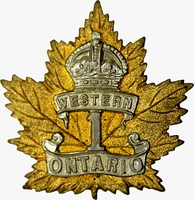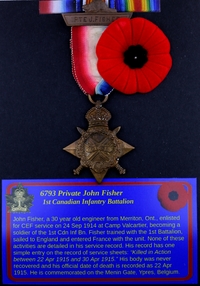
6793 Private John Andrew Fisher
1st Canadian Infantry Battalion
By: Capt (ret'd) Michael M. O'Leary, CD, The RCR
John Fisher, a 30 year old engineer from Merriton, Ontario, enlisted for overseas service in the Canadian Expeditionary Force on 24 Sep 1914 at Camp Valcartier, Quebec. A soldier of the first contingent of the CEF, Fisher was taken into the 1st Canadian Infantry Battalion and assigned the regimental number 6793. He is described in his attestation paper as 5 feet, 8 inches in height, with a 32.5-inch chest, dark complexion, blue eyes, and brown hair.
Fisher was born at Merriton and that is where his father William, who was noted as John's next of kin, was still living in 1914. Fisher's attestation paper records that he was a member of the Canadian Militia when he enlisted, but does not specify his unit. As a single man, his service record does not give an address for his last place of residence, and we cannot necessarily assume he was living with his father.
Fisher trained with the 1st Battalion, sailed to England and entered France with the unit. None of these activities are detailed in his service record. His record has one simple entry on the record of service sheets: "Killed in Action between 22 Apr 1915 and 30 Apr 1915."
That simple note indicates how pressed the Battalion, as part of the 1st Canadian Infantry Division, was during those critical days of April 1915. Starting with the first German gas attack on 22 April and the 1st Battalion being thrown into the line to stop the very nearly successful German breakout, it was not even possible for the survivors to establish exactly when Fisher fell in combat.
The so-named "Battle Bar Ledgers" prepared after the war by the Department of Defence (in anticipation of clasps being issued for the British War Medal) provides the following outline for the 1st Battalion's activities in late April, 1915:
ST JULIEN; Div Reserve — VLAMERTINGHE Sheet 28.NW H.2.a; Trenches
- 21-22 Apr 1915; Divisional Reserve
- 23 Apr 1915; Forward Line of Troops, Supporting attack by French Army on PILKEM VILLAGE.
- 24-25 Apr 1915; Local Support, In attack on ST JULIEN.
- 26-28 Apr 1915; Local Support, In support holding YSER CANAL.
- 29-30 Apr 1915; Divisional Reserve.
Fisher's Circumstances of Death record sheet held by Library and Archives Canada notes "Killed in Action" and gives a location only as "Vicinity of St Julien."
The War Diary of the 1st Canadian Infantry Battalion for April 1915 provides a "Narrative of Operations, 23rd to 30th April 1915." This narrative reads:
FIRST CANADIAN BATTALION.
Narrative of operations 23rd to 30th April, 1915.
Ref. Sheet 28, 1/40,000
On the morning of the 23rd April at 1.40 A.M. The 1st and 4th Canadian Bns moved from VLAMERTINGHE via BRIELEN and crossed the YSER CANAL—4th Battalion leading.
These units then occupied a position on the east side of the CANAL facing NORTH along the track leading EAST from the bridge (Pontoon No. 4) 500 yards south of the first bend in the CANAL north of YPRES. This position extended from the YPRES—PILCKEM road, inclusive, to the CANAL. Th 4th Canadian Battalion was on the right.
Col. GEDDES, the Buffs, with 3 Bns. was expected to advance through the position occupied to the NORTH.
At 5 A.M. the Canadian Bns. were ordered to attack in the direction of PILCKEM village with their left resting on the YPRES—PILCKEM road supporting an attack by the FRENCH on their left and to maintain contact with Col. GEDDES' force on their right. The 4th Bn was directed to lead the advance, the 1st Bn supporting.
The ridge 1200 yards SOUTH of PILCKEM was occupied by the enemy and was the first objective.
The attack was launched under heavy artillery, machine gun and rifle fire and without artillery preparation. The only artillery support was afforded by one Batty in rear.
On our advance the enemy retired from some advanced trenches he had occupied to his main position on the ridge.
At 9:30 A.M. after reaching a point 500 yards from the crest of the ridge the attacking force was ordered to halt and entrench.
At 3:48 P.M. the FRENCH advanced to attack on our left and at the same time Col. GEDDES' force advanced through our entrenched position. The Canadian Bns, went forward with this force leaving a sufficient garrison in the entrenched position already gained.
In support of this position the local reserve of the 1st Canadian Bn, had in the morning thrown up a a strong line of trenches facing PILCKEM ridge on the high ground near the track leading from the CANAL bridge.
The afternoon attack reached a point within 200 yards of the enemy's main position on the ridge but being too thin and insufficiently supported by artillery the attack failed to gain its objective, but the ground gained was held.
At 11:50 P.M, the advanced troops were relieved and the 1st Canadian Bn was ordered to occupy the line of trenches constructed by the local reserve in the morning and act as a reserve to the front line. This position was held until 7 P.M. the 24th inst. under very heavy artillery, machine gun and rifle fire.
During the morning 24th inst. the FRENCH developed an attack on our left which was unsuccessful but some ground was gained.
At 7 P.M. the 24th inst, the 1st Canadian Bn, was ordered to march towards FORTUIN via WIELTJE and on reaching a point 200 yards south of FORTUIN entrenched facing NORTH, supporting an attack on ST. JULIEN.
The Bn remained in these supporting trenches under heavy fire until 8 P.M. the Bn, was withdrawn and marched to the west bank of the YSER CANAL at PONTOON bridge No. 4—the point of crossing on the 23rd inst. and occupied a position covering the ground between the 3rd and 5th PONTOON BRIDGES. This position mas maintained under heavy artillery fire until the evening of the 28th inst.
At 6:80 P.M, the 28th inst. the Bn with the remainder of the 1st Canadian Inf. Bde crossed the canal road constructed a line of trenches between the farms C22a and C22b and also assisted the Rifle Bde in building and repairing their trenches, later withdrawing to VLAMERTINGHE.
The casualties suffered during the period 23rd to 30th inst. were: officers—killed 3, wounded 7; other ranks—killed 58, wounded 306, missing 34. Nearly all these casualties occurred on the 23rd inst.
The conduct of all ranks was all that could possibly be desired and their devotion to duty and steadiness remarkable.
F.W. Hill
Comdg., 1st Canadian Battalion
1 May 1915
The 1st Canadian Infantry Battalion was awarded three Battle Honours for actions covering April 1915. These Battle Honours are now carried by The Royal Canadian Regiment, which perpetuates the 1st Canadian Infantry Battalion.
- Ypres, 1915 (22 April — 25 May 1915)
- Gravenstafel Ridge (22-23 April 1915)
- St Julien (24 April — 4 May 1915)
Among the 1st Battalion's casualties during those operations was Private John Fisher. His body was never recovered and identified. Fisher's official date of death is recorded as 22 April 1915. He is commemorated on the Menin Gate, Ypres, Belgium.
John Fisher's medals were sent to his father in 1921. These consisted of the 1914-15 Star, the British War Medal, and the Victory Medal. William Fisher would have also received a bronze Memorial Plaque to commemorate his son's death. As John Fisher was unmarried and with no record of his mother in his file (likely pre-deceased), no Memorial Cross was issued inscribed with his name.
Pro Patria
Visit a randomly selected page in The O'Leary Collection (or reload for another choice):
![]()
![]() 478022 Private William Witherow
478022 Private William Witherow ![]()
"Single, had measles, malaria, enteric, and dysentery in India. Uses alcohol and tobacco."
- The O'Leary Collection; Medals of The Royal Canadian Regiment.
- Researching Canadian Soldiers of the First World War
- Researching The Royal Canadian Regiment
- The RCR in the First World War
- Badges of The RCR
- The Senior Subaltern
- The Minute Book (blog)
- Rogue Papers
- Tactical Primers
- The Regimental Library
- Battle Honours
- Perpetuation of the CEF
- A Miscellany
- Quotes
- The Frontenac Times
- Site Map
QUICK LINKS
The O'Leary Collection—Medals of The Royal Canadian Regiment
Newest additions:
![]()
![]() SB-12725 Private Henry "Hank" Ard
SB-12725 Private Henry "Hank" Ard ![]()
WIA at Hill 187, Died of Wounds in Japan
![]()
![]() 2355331 Lance Corporal Albert Lorking
2355331 Lance Corporal Albert Lorking
Wounded in action, later a War Amps representative.
![]()
![]() 4334 / 477996 Pte Isaac Hamilton Wilcox
4334 / 477996 Pte Isaac Hamilton Wilcox
Permanent Force, South Africa, and C.E.F.
![]()
![]() 477019 Private Harold Ashcroft
477019 Private Harold Ashcroft
Transferred to the Tunnelers.
![]()
![]() 734231 Private Clark D. Thompson
734231 Private Clark D. Thompson ![]()
The older Thompson brother, killed in action.
![]()
![]() 733849 Private Norman Parker Thompson
733849 Private Norman Parker Thompson
The younger Thompson brother; post-war service in the Special Guard.
![]()
![]()
![]() A305 / 400305 Private Andrew Walker
A305 / 400305 Private Andrew Walker ![]()
"Previously reported Wounded, now Killed in Action."
![]()
![]() 823298 Pte Thomas Patrick Steele, M.M.
823298 Pte Thomas Patrick Steele, M.M. ![]()
… for gallant conduct in the field …
![]()
![]() P13066 Sergeant Harold Thompson
P13066 Sergeant Harold Thompson
Instrumental Soloist for over 20 years of Canadian Army service.
![]()
![]() 9609 / 477728 Private Albert Edward Piper
9609 / 477728 Private Albert Edward Piper
"Arrived from England as a STOWAWAY …"


